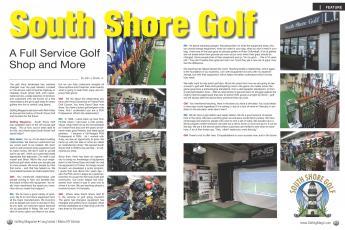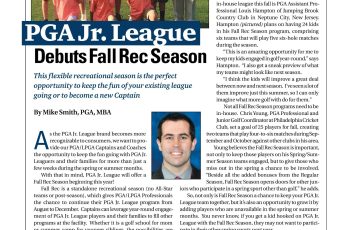WHAT IF? The equipment business is already ramping up for next year even though many consumers worldwide have closed out another playing season. Looking back on 2019, there wasn’t a run away, hot product that consumers went flocking towards. It was, in fact in many ways a quiet year on the equipment front. It’s believed that domestic equipment sales through the month of September, according to sources, are only slightly ahead of 2018’s pace. But there was an interesting trend that happened, yet was never reported.
Is it the archer or the arrow? It’s been an age-old question. For many aspirational players something new in the bag can often motivate and inspire them to play more frequently. According to Golf Datatech research, despite rounds played in the month of August up 3.5% nationally, year-to-date it is exactly the same as the year before. It helps to support the argument that equipment trends may have run their course and players are becoming less inspired with the latest and greatest coming from manufacturers. Agree to disagree? The days of 20 yards longer now seem like a fairytale. More time and words have been devoted in recent years towards rolling back distance that promoting gains.
Distance remains the #1 selling feature consumers are looking for. Often new products are sold with the implied belief that said product will make each of us a better player. However, it begins with the internal conviction that we are immediately better by simply having the club or ball in our possession. The interesting aspect of this phenomenon is that it’s universal. Whether you are a TOUR pro or a weekend warrior, you must have belief in the products you are playing.
Avid players, which are the most coveted buyers manufacturers and retailers vie for, pay close attention to equipment trends on TOUR. When something new appears in a player’s bag it immediately attracts attention. If it finds the winner’s circle it becomes further validated. Week after week, it can become tricky to remember what worked for one player or another. As the saying goes, to each their own. Factor in the economic stimulus PGA TOUR players are presented with and the topic appears a little more confusing. Nevertheless, not all players have seen success after making a switch. In fact some have been known to move back into something they had success with in the past thus attesting to the notion that you must have complete faith in what you play for a chance of success. There were several examples of this happening, yet you didn’t hear anything made of it.
Case in point, there is a clear difference between being a “free agent” and being under contract to play a brand’s equipment, yet playing another’s. The current World No. 1, Brooks Koepka is a “free agent” who chooses to play Titleist’s Pro V1x golf ball without an agreement. It is also happens to be the golf ball with which he has won four major championships since returning to it in January 2017.
Patrick Reed is another “free agent” who won the 2018 Masters trusting the Titleist Pro V1, just five events after switching from a competitive brand (Callaway). In fact, he played three different competitive brands (Callaway, TaylorMade, Bridgestone) in the year leading up to his first major title before even trying and settling on Titleist
Gary Woodland, yet another “free agent” when he won the 2019 U.S. Open switched to the Titleist Pro V1 from Bridgestone, according to TOUR sources just four weeks prior. Woodland has since officially joined the Titleist golf ball roster and recently finished 5th at the ZOZO Championship. Then there are those players who are paid to play their sponsor’s golf ball, but instead play and win using a Titleist even though they don’t have an agreement.
For the second time in two months, a full product line, high profile player from a competitive brand made the switch to a Titleist golf ball and won on the European Tour. The first came in September, when the KLM Open champion, Sergio Garcia, who made his switch at The Northern Trust, according to sources, claimed victory in just his third event after transitioning to the Titleist Pro V1. Another player is Nicolas Colsaerts, who fell from a career-high of World No. 32 in May of 2012, to as low as No. 424 just last month. He switched to the Titleist Pro V1x at the KLM Open. In danger of losing his European Tour card for next season, Colsaerts switched from the same competitive brand as Garcia, sources report, and went on to capture the French Open in just his sixth event since putting the Titleist Pro V1x in play. The 2012 Ryder Cup participant returned to the winners’ circle for the first time in seven years!
Another high profile convert is Daniel Berger. He was ranked as high as No. 18 in June of 2017 and has fallen down to No. 141. After finishing outside the top 125 in the 2018-19 FedExCup Rankings, Berger had five starts on a minor medical exemption to earn 15 FedExCup points and retain his PGA TOUR card for the new season.
While still under contract with Callaway, Berger moved back to Titleist and the Pro V1 to start the new campaign. He finished T-23 at the season-opening Safeway Open, more than doubling the required point total to keep his job. He followed with a T-18 at the Shriners Hospitals for Children Open, earning another 39 FedExCup points. Ironically, Berger had gone to Twitter in January of 2018 and stated, “I switched to the chrome soft last year and I will say I’m a better golfer because of it. Try it before knocking it.” Berger finished T17 at the ZOZO Championship.
Kevin Na won the Shriners Hospitals For Children Open using a Titleist ball. He made a PGA TOUR record 558’11” of putts for the week. Was it the putter, ball or both? Na used an Odyssey Toulon Madison putter in his victory. You be the judge.
Now it could be interpreted that Callaway’s ball isn’t everything it claims to be. That isn’t the case. The players noted found success going to something they already knew. Callaway has seen success with its ball on TOUR. Danny Willett won the BMW PGA Championship on the European Tour with a Chrome Soft X ball. Maverick McNealy earned his PGA TOUR Card by finishing in the top 25 on the Korn Ferry Tour regular season standings. He plays a Chrome Soft X.
However, the defections aren’t just from one brand, as two of the most high-profile players coming out of college this year are contracted to play the golf ball and full product line of TaylorMade equipment. Yet both won for the first time on the PGA TOUR playing a Titleist golf ball. Collin Morikawa won his first PGA TOUR event at the 2019 Barracuda Championship in only his fourth start as a professional. He won playing the Titleist Pro V1x and went on to advance to the BMW Championship in the FedExCup Playoffs. Morikawa started the new season playing a TaylorMade golf ball, according to TOUR sources, but returned to the Titleist Pro V1x at the CJ Cup after just two starts. He played it again at the ZOZO Championship. Matthew Wolff won the 3M Open in just his third start as a professional playing the Pro V1. He started the 2019-20 season playing TaylorMade. But what if this wasn’t about a golf ball? What if it was a driver? It would make a lot more noise both with the media, retailers and certainly with consumers.
Golfers have worshipped at the altar of new for many years, if not decades. And they will continue to. The contention is that it offers hope that one’s game is going to see immediate improvement. Yet, some of the best went back to something they already knew and it paid big dividends. Had it not been a ball, chances are it would have generated more excitement. But the facts speak for themselves. Good products are no longer as hard to find today as they were 5/10/15 or 20 years ago. But knowing what works for your game is still a tricky proposition, especially when more variables are entered into the equation each time something new arrives. It can often be a trial and error experiment. The ultimate challenge is finding the solutions versus adding to the problem!





Leave a Comment
You must be logged in to post a comment.